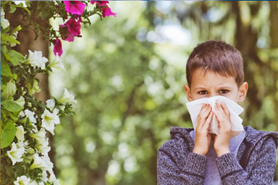Overcome by hay fever: taking on the pollen calendar
Hay fever is a common allergic reaction to pollen from grasses, trees, plants, herbs and flowers. This reaction can lead to unpleasant symptoms such as itchy eyes, a runny nose, sneezing and shortness of breath. Pollen allergies are often aggravated by certain types of pollen that are released in different seasons. To help people manage and reduce their allergies, there is the pollen calendar. This blog explains how to use the hay fever pollen calendar, so that people can be better prepared and reduce their symptoms.
What are pollens and what is a pollen allergy?
Pollen plays a major role in the fertilization of plants, flowers, trees and grasses. Pollen is made in the stamens of male flowers and is actually a vegetable seed. The pollen must end up on the pistil of a similar flower via the wind or via the legs of insects, and then fertilization takes place.
With a pollen allergy or hay fever you are allergic to the pollen of trees, flowers, grasses and plants. When the pollen comes into contact with the mucous membrane of your nose, eyes or throat, your body produces a substance histamine. Histamine causes your mucous membranes to swell and become irritated, with all the consequences that entails.
What types of pollen are there?
Pollen comes in two different types: light, dusty pollen and heavy, sticky pollen. Hay fever and pollen allergies are mainly caused by the first type. It has been shown that there is a higher sensitivity to certain pollens. Below you can read the most common ones.
Pollen from trees
All trees spread pollen, but there are a few tree species whose pollen is known to hay fever sufferers. These are the birch, the alder and the hazel.
Pollen from plants/(weeds)
Among plants and herbs, the pollen of the ragweed, mugwort, plantain and sorrel are particularly known for their pollen, which can cause complaints in hay fever patients. These plants flower mainly in the summer and autumn.
Grass pollen
Grass pollen is the most common trigger for an allergic reaction. Many people with hay fever have a specific allergy to grass. Due to the wide variety of grasses that flower in succession, the period when grass pollen is in the air can be long. The first pollen from different grasses usually appears in early May, followed by an extensive flowering period in June. This can be a difficult time for people with grass allergies, as the symptoms of grass allergy overlap with those of hay fever. Some people may also experience a rash around the mouth after eating certain foods such as nuts, bananas, apples, grapes and peaches, due to the similarity of proteins to those in grass pollen.
What is a pollen calendar and how does it work?
If you want to go outside without any worries, for example for a picnic or a walk, the Netherlands pollen calendar can show you exactly when you need to watch out for your pollen allergy.
The pollen calendar can be used in several ways:
- In this calendar you can see exactly when the pollen you are allergic to occurs
- In this pollen calendar you can see which pollens you are probably allergic to, depending on which months you suffer from allergic reactions.
Curious about when which type of pollen grows at what time of year?

If you are allergic to pollen, it is useful to have an allergy test done by your GP. With the pollen calendar you can see which pollens are active in which months and when you need to prepare extra. If you are not sure which pollens you are allergic to, you can also consult your GP and use the pollen calendar to make a better estimate. If you only suffer from symptoms in certain months, this may be an indication of which pollens you are allergic to. In the months of May to September, there are many different types of pollen in the air, which makes it more difficult to determine which pollens you are allergic to. In that case, it is advisable to consult your GP.
Other tools
Another tool is the pollen radar or the hay fever radar. These show whether there is a lot of pollen in the air. The flowering periods of the pollen that are strongly allergenic and in that case are also often responsible for common hay fever complaints have been examined.
Sources:
Allegra
All about allergy
A.Vogel
Hayfever.com
Hay fever radar


